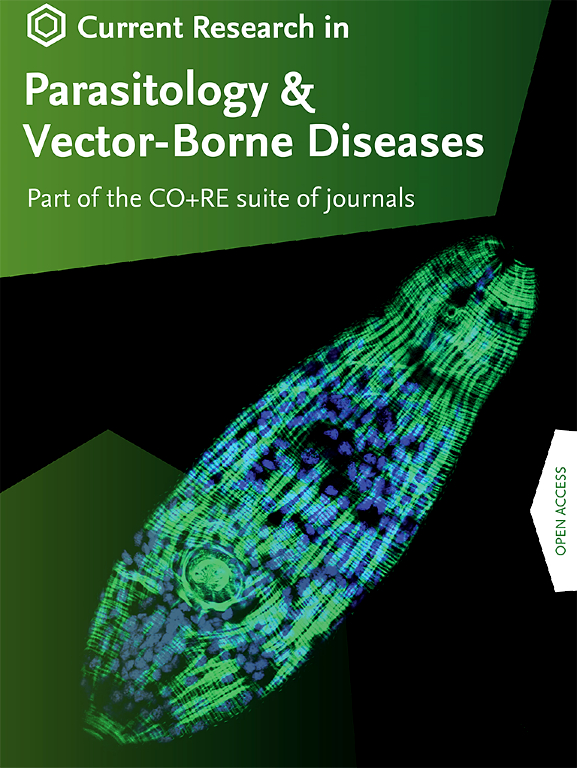Ver ítem
- xmlui.general.dspace_homeCentros e Institutos de InvestigaciónCICVyA. Centro de Investigación en Ciencias Veterinarias y AgronómicasInstituto de PatobiologíaArtículos científicosxmlui.ArtifactBrowser.ItemViewer.trail
- Inicio
- Centros e Institutos de Investigación
- CICVyA. Centro de Investigación en Ciencias Veterinarias y Agronómicas
- Instituto de Patobiología
- Artículos científicos
- Ver ítem
Prevalence, risk factors and molecular epidemiology of neonatal cryptosporidiosis of calves : The Argentine perspective
Resumen
Cryptosporidium spp. are enteroparasitic protozoans that cause cryptosporidiosis in newborn calves. Clinical signs of the infection are diarrhoea and dehydration leading to decreased productivity and economic losses in cattle farms around the world. Additionally, cryptosporidiosis is a relevant zoonotic disease since the ingestion of oocysts can be fatal for children under five years of age, the elderly, and/or immunocompromised adults. This review aims
[ver mas...]
Cryptosporidium spp. are enteroparasitic protozoans that cause cryptosporidiosis in newborn calves. Clinical signs of the infection are diarrhoea and dehydration leading to decreased productivity and economic losses in cattle farms around the world. Additionally, cryptosporidiosis is a relevant zoonotic disease since the ingestion of oocysts can be fatal for children under five years of age, the elderly, and/or immunocompromised adults. This review aims to integrate existing knowledge on the epidemiological situation of calf cryptosporidiosis and associated risk factors in Argentina. In addition, the GP60 subtype diversity of the pathogen was analysed and related with the global distribution of corresponding GP60 subtypes. Depending on the study region and applied diagnostics, prevalence among calves up to 20 days of age varied between 25.2% and 42.5%, while a prevalence of 16.3–25.5% was observed at the age of 1–90 days. So far, molecular studies have determined exclusively Cryptosporidium parvum in preweaned calves. In addition, C. parvum infection was reported as the major cause of calf diarrhoea, followed by rotavirus A (RVA), while enteropathogens such as coronavirus, Escherichia coli, and Salmonella sp. played a negligible role. Calf age of 20 days or less, incidence of diarrhoea, poorly drained soils, and large farm size were identified as risk factors for C. parvum-infection in Argentina. A total of nine GP60 subtypes (IIaAxxG1R1, xx = 16 to 24) were identified, showing a stepwise increase of the trinucleotide motif TCA, and including the zoonotic subtypes IIaA16G1R1, IIaA17G1R1, IIaA18G1R1, IIaA19G1R1, and IIaA20G1R1. We found that an increase in the A16→A24 trinucleotide repeat was accompanied by a gradual decrease in the global distribution of GP60 alleles, strongly suggesting that IIaA16G1R1 represents the primordial allelic variant of this group. Since identified GP60 alleles have a similar genetic background, we hypothesize that the continuous trinucleotide repeat array has been generated by stepwise repeat expansion of A16. The information gathered and integrated in this study contributes to an improved understanding of the epidemiological characteristics of bovine cryptosporidiosis in and beyond Argentina, which in turn can help to develop control strategies for this parasitosis of veterinary and medical relevance.
[Cerrar]

Autor
Fuente
Current Research in Parasitology & Vector-Borne Diseases 4 : 100147 (Available online 4 October 2023)
Fecha
2023-10
Editorial
Elsevier
ISSN
2667-114X
Documentos Relacionados
Formato
pdf
Tipo de documento
artículo
Proyectos
(ver más)
INTA/2019-PD-E5-I102-001, Desarrollo de vacunas y tecnologías para mejorar las estrategias profilácticas y terapéuticas de las enfermedades que afectan la producción animal y la salud pública
INTA/2019-PD-E5-I103-001, Desarrollo de tecnologías diagnósticas y estudios epidemiológicos para el control de enfermedades que afectan la producción animal y la salud pública
INTA/2023-PD-L01-I118, Innovaciones en los procesos de crianza, recría y vaca en transición de rodeos lecheros
Palabras Claves
Derechos de acceso
Abierto
 Excepto donde se diga explicitamente, este item se publica bajo la siguiente descripción: Creative Commons Attribution-NonCommercial-ShareAlike 2.5 Unported (CC BY-NC-SA 2.5)
Excepto donde se diga explicitamente, este item se publica bajo la siguiente descripción: Creative Commons Attribution-NonCommercial-ShareAlike 2.5 Unported (CC BY-NC-SA 2.5)


